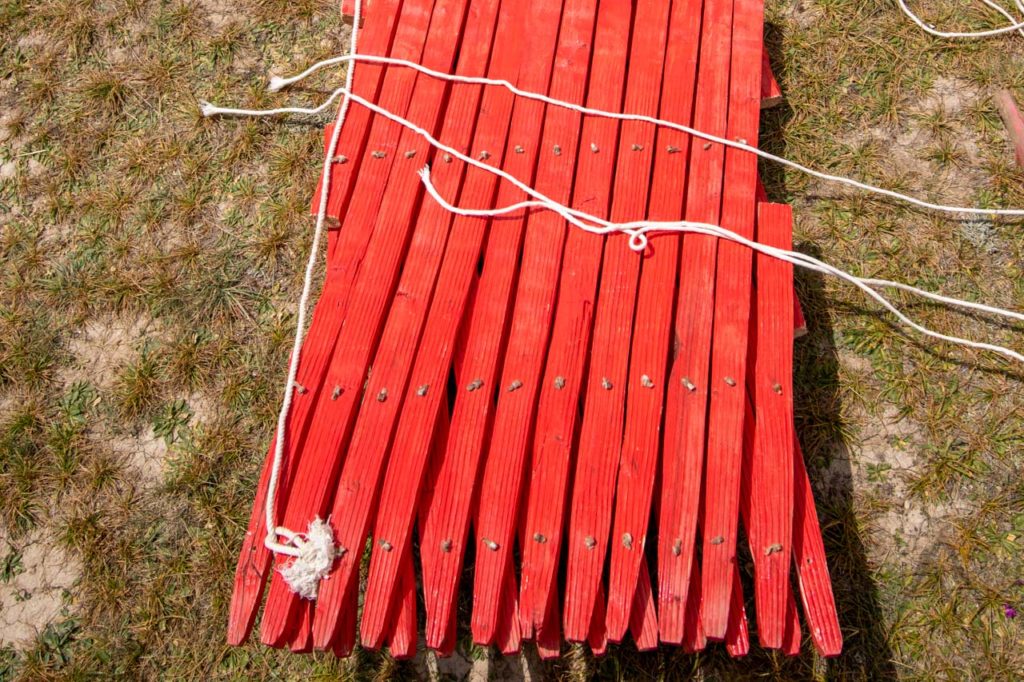Kyrgyz Yurt
Kyrgyz Yurt
Yurt is a nomadic dwelling, used mostly by Kyrgyz, Kazakh and Mongol people. In Kyrgyzstan, it is referred as “booz yi” which translates as a grey house. Yurt is a significant part of Kyrgyz culture having its part from rituals and ceremonies to craftsmanship and traditional artistry. Yurts exist all around the Eurasia, however with slightly various materials, dimensions or traditions but the yurt culture is best preserved in Kyrgyzstan. Therefore, many of our Kyrgyzstan Tours and Central Asia Tours include yurt construction in Kyrgyzstan.
Kyrgyz yurts are composed of cupola made from birch poles tied to a wooden, usually red painted, latticework that forms the vertical walls. According to the notes of N. M. Przhevalsky, the Russian geographer and explorer of Central Asia “The yurt is the perfect example of an indispensable home. It can be quickly disassembled and transferred to another place and it serves well as sufficient protection from the cold, heat and bad weather. Indeed, inside a yurt, with a fire burning, it’s quite warm, even in the most severe frost (but it gets also very cold after the fire dies out). In the summer, the felt shell of such a dwelling protects perfectly from heat and rain.


The cover of the yurt is made of felt and wool, which is water-repellent and warm and can be easily repaired when needed. The folding wooden walls of the yurt are called “kerege”. The roof of the yurt is held up by wooden beams and they support the rooftop of a yurt called “Tunduk”.
Tunduk forms one of the most essential symbols of family and the universe. A small strip of felt covers the tunduk, which can be opened when the weather is nice to let in light and fresh air, and closed when the weather is cold and wet. The tunduk is one of the important schemes in Kyrgyzstan and is used also on the Kyrgyz flag.
Yurt structure and order
Normally, one yurt was for one family, however, depending on the family’s wealth they may have additional yurts apart from the main one. There were also separate yurts for cooking, a yurt for guests, as well as there were staged on the occasion of major holidays, funerals, or commemoration. The rich Kyrgyz, marrying their daughters, set up wedding yurts (Erge), which were considered the main part of the settlement for the bride.
Before the Soviet period, the collectivization of the nomadic lifestyle was the yurt and after the independence of Kyrgyzstan, some people moved back to this lifestyle especially for the purpose of livestock herding at the alpine jailoo (alpine meadow for summer grazing).


The fire was usually kept in the middle of the yurt during the wintertime and the holes in tunduk allows the smoke to escape. Nowadays yurts mostly have a small chimney and coal or dried dung is burned for heat and cooking purposes.


The place opposite of entrance was considered an honorary position (tor). It was the place for the most honored guests and the “center” of the yurt. If you are a guest you are usually offered to sit there, however, if a person more honorable than you shows up, the master will tell you clearly “Give your place to him!”. And you will have to give up that spot before all the guests.


Sleeping in a yurt
There are usually piles of blankets at the side of yurt that will be spread at night for sleeping but tourists can also choose to sleep in the more comfortable beds that are also warmer during the night than the blankets on the ground. Additional textiles include shyrdaks (carpet made of felt sewn together in a pattern), decorations and felt objects that are also partly used to enhance the yurt. Most of the designs and ornaments for these traditional crafts came from nature as the nomads of course lived close to nature and still do.
Finally, the atmosphere and acoustics in a yurt are very nice, somehow the soft walls and the round shape make the acoustics very soft and it is hard sometimes to recognize the direction of the sounds. The easiest destinations to experience sleeping in a yurt is in one of the yurt villages at the southern shore of Issyk Kul and Song Kul.
Sleeping in a yurt is also a part of most of our Kyrgyzstan tours!


Best places to enjoy yurt life in Kyrgyzstan
Page updated 17.1.2021